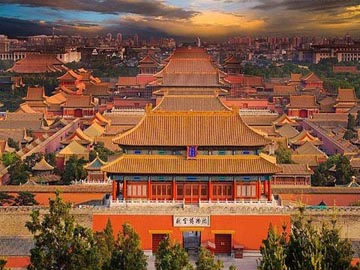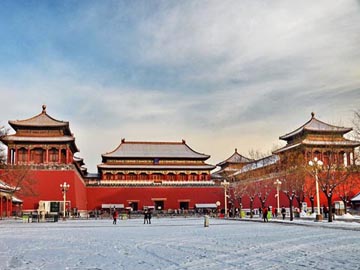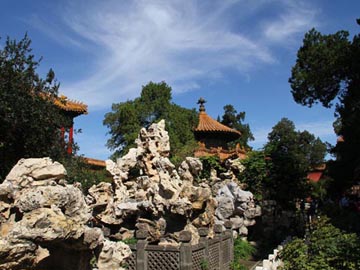|
 |
 |
Panorama
of the Forbidden City |
The
Main Gate of the Forbidden City, the Meridian Gate |
More Stories about
the Forbidden City.
The Meridian Gate It is the outer front gate and also
the southern gate of the Forbidden City, embodying the solemnity and dignity
of the Imperial Palace. With five pavilions on top, it is also called
“Five-phoenix Tower”. It formed into the shape of the letter “U”. There
are three main gateways and two side gateways through it. The central
gateway was exclusively reserved for the emperor, but the empress had
the right to go through it only once in her life at her wedding ceremony
and the scholars who came the first, the second and the third in the Imperial
Examination presided over by the emperor were permitted to leave the palace
through it. All other high-ranking officials were permitted to go through
the left gateway and the members of the royal family were permitted to
go through the right gateway. The other petty officials could do the entry
by the two side gateways.
There are bell tower and drum tower built on top. When the emperor presided
in court drum would be beaten and bell would be sounded. When the emperor
went to the Temple of Heaven to offer sacrifice the bell would be sounded.
The drum would be beaten when the emperor went to the Ancestral Temple
to offer sacrifices.
Every Winter Solstice, the emperor would promulgate the next year’s lunar
almanac on the Meridian Gate. "The “Presenting captives’ ceremony”
was held in front the Meridian Gate. The generals would present captives
from the victory wars to the emperor to get awards here in the Qing Dynasty.
In the Ming Dynasty, the place in front of the Meridian Gate was also
used for punishing the officials who offended the emperor, by flogging
on the bottom. That was called” Court Flogging”. In 1519, the ministers
advised the emperor to cancel a trip to South China. That made the emperor
very angry because he wanted to choose more beauties by that tour. So
he had some 130 officials flogged by court guards. 11 of them died of
the torture. In 1524, one emperor had 134 officials published on one time
and 17 of them were beaten to death on the spot. In Qing Dynasty this
cruel practice was abolished.
The Gate of Supreme Harmony It is the front gate of the
three main outer halls in the Forbidden City. In the Ming Dynasty, it
was a place for the emperors to hear the reports by his officials and
also to make important decisions. In the Qing Dynasty, the emperor would
alight from his carried chair to take a canopied chariot here on the way
to offer sacrifices to altar temples. The Qing emperors once held the
banquets here. Ceremonies for receiving dowry, wedding and conferring
the title to the empress would pass this gate.
 |
 |
| The Hall of Supreme Harmony, the Throne Hall | The
Amperor's Throne |
The Hall of Supreme
Harmony Every year, grand celebrations were held here on the
first day of the first lunar month, the day of the Winter Solstice and
the emperor’s birthday. Other important ceremonies such as issuing the
imperial edict about the new emperor’s enthronement, announcing the list
of the successful candidates from the imperial examination and dispatching
a general on an expedition would be held here. Imperial examinations were
held here in the Ming Dynasty and the beginning of the Qing Dynasty.
The Hall of Complete Harmony Before going to the Hall
of Supreme Harmony for grand ceremonies, the emperor would take a short
rest here and make some preparations. The emperor could receive his ministers
to listen to the report about the arrangement of the ceremony. The emperor
also reviewed the sacrificial address before going to the Temple of Heaven
to offer sacrifice. Before the sacrifice was offered at the Temple of
Agriculture, the emperor would hold a ceremony to check the grain seeds
for sowing and the farming tools for use.
The Hall of Preserving Harmony In the early days of the
Ming Dynasty, banquets were set to entertain the emperor’s son in law
and other top officials. In the later period of the 18th century, it was
a place for palace examinations. In the Qing Dynasty, banquet was given
here on every New Year’s Eve for entertaining the Mongolian nobles and
officials.
He in Chinese means the harmonized relation among various
things in the world. Taihe means that the relations between various things
in universe are in perfect. Zhonghe means impartial, i.e. to handle things
in a proper and restrained way so that relations between the various things
could be kept in harmony without going astray. Baohe denotes to keep in
order the harmonized relations already obtained between various things.
The Hall of Heavenly Purity From the Ming Dynasty to
the early days of the Qing Dynasty, it was a place where the emperors
resided and handled his routine affairs. During Emperor Yongzheng’s Reign
period, he moved to work and stay in the Hall of Mental Cultivation. Occasionally
he came here to receive his officials and envoys, go over memorials and
work out policies. After the emperor died, his coffin would be laid here
for a few days. From Emperor Kangxi, the crowned prince would not be announced
avoiding the princes’ killing each other. The emperor would write down
the name of heir prince on one paper and seal it inside a box, which would
be put behind the board of “Being Open and Aboveboard” in this hall. When
the emperor passed away, the box would be opened and the successor to
throne would be announced right on the spot.
The Hall of Union and Peace Celebration was held here
on the birthday of the empress. In 1748, Emperor Qianlong put 25 imperial
seals representing the supreme royal power here. Besides, some clocks
and a copper clepsydra were placed here. In the Qing Dynasty, the ceremonial
rites would be held here before the empress went out to offer sacrifice
on the Altar of Silkworm.
The Hall of Earthly Tranquility In the Ming Dynasty,
it was called “Central Palace” lived by the empress. In the Qing Dynasty,
the west part became a place to offer sacrifices to gods, the east part
was the bridal chamber for the emperor and the empress. Emperor Kangxi,
Emperor Tonzhi and Emperor Guangxu all were married here.
The Hall of Mental Cultivation
From the Emperor Yongzheng to the end of the Qing Dynasty, the hall was
a place where the emperor lived. The room in the middle was used to receive
ministers and foreign envoys. The books on the shelf were the experiences
and lessons gained by the previous emperors. They were left for the coming
emperors. The emperor used the western room to read and comment memorials
and planned political and military decisions together with ministers.
The eastern room was a place for Empress Dowager Cixi to exercise her
“Ruling Behind the Curtain” during the reigning periods of Tongzhi and
Guangxu. In 1911 the imperial edict of abdication was announced from here.
The rear hall was the bedchamber of the emperor. Shunzhi, Qianlong and
Tongzhi in Qing Dynasty all passed away here.
Sundial and grain
measures
The Sun Dial, a time-meter invented in
ancient China and firstly was used in Qin Dynasty 2,000 years ago. Using
the projection by sun and the principle of the rotation of the earth,
ittells time by shadow
projected by handle on the dial-panel
with an inclination angle of 50 degrees. In the center of the sundial
panel, standing an iron handle at a right angle. Its upper tip points
to the North Pole and the other end to the South Pole.
 |
 |
The
Emperor's Bed Room |
The
Imperial Garden |
On both sides of the
dial-penal are carved with a time divisions of the 12 two-hour periods.
From morning to night the shadow of the handle on the upper side of the
dial goes anti-clockwise and the handle on other side goes the other way
around. After Vernal Equinox the time is read by the shadow on the upper
side and by that on reverse side after the Autumnal Equinox. The Imperial
Grain Measure “Jialiang” It was a complete set of standard volume measures
in ancient China. The whole set consists of five volume units: Hu, Dou,
Sheng, He and Yue. In accordance with the traditional system, two “Yue”
equal to a “He”, ten “he” equal to a “Sheng”, ten “Sheng” equal to a “Dou”,
and ten “Dou” equal to a “Hu”. But latter changed into five “Dou” a “Hu”.
Eunuch in Feudal China Eunuchs were castrated male attendants
whose official job was to supervise the management of daily business in
the palace and look after the emperors’ life. Using the eunuchs in the
court had existed for more than 2,000 years. In the Ming Dynasty, by the
time of Wanli (1573-1620) there were over ten thousand eunuchs in the
capital. The eunuchs lived close to the emperor to serve the royal family.
So they became crucial intermediaries between the outer bureaucrats and
the inner royal members. Some bad eunuchs became very powerful and tyrannical
to persecute the faithful and honest, which would lead the politics to
darkness. Like Weizhongxian, a famous eunuch in the Ming Dynasty, he was
so powerful that he even could dominate to choose the succeeding emperor.
In the beginning of the Qing Dynasty, strict laws were made to restrain
the behaviors of eunuchs. But later eunuchs became powerful again because
Empress Dowager Cixi needed to collide with them to rule China. For example,
Eunuch Liliangying was a famous, powerful and favored one in the late
of the Qing Dynasty.
Coffered ceiling It is called the skylight in ancient
times. With beautiful decorations such as dragons and flowers it was only
used on palatial buildings, temples or mansions for reverend lords to
show the masters’ dignity and solemnity; no houses of common people were
allowed to use it. A concave in the shape of well was made at the most
important part of the ceiling of a building, such as above the throne
or Buddha statue, hence the name” coffered ceiling” It was also said that
the coffered ceiling could keep the fire.
The five famous Famous palaces in the world
The Forbidden City In Beijing, China, Buckingham Palace in England, White
House in America, Chateau de Versailles in France, Kremlin in Russia.
Mobile:(+86-1350 110 3837) Fax:(0086-10-6585 4230) E-mail: chinasilkrug@msn.com